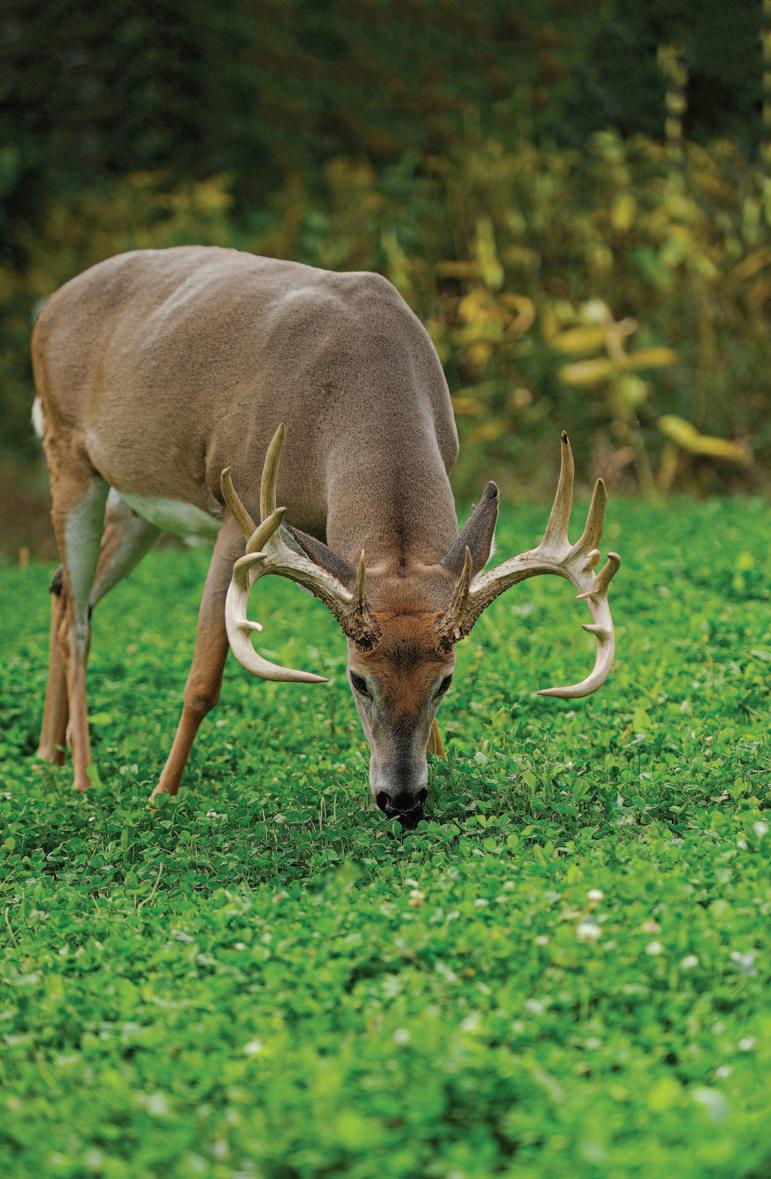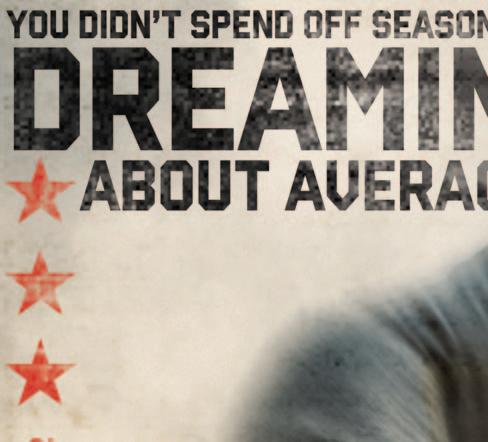
7 minute read
Frost Seeding: How to Boost the Performance of Your Perennial Plots
By Scott Bestul Photo by Charles J. Alsheimer
’ve planted plenty of clover plots, but this one was special. I always start my favorite phase of the year — trailcam season — about July 4, and perennial plots are among my favorite sites to hang the season’s first cameras. When I walked into the one-acre plot of Imperial Whitetail Clover to get the festivities started, my jaw dropped at the lush and seemingly perfect clover I had to wade through to reach my camera tree. The plot was covered with emeraldgreen clover and apparently devoid of weeds.
Advertisement
As I admired the gorgeous growth, I could think of only one thing that distinguished this clover plot from the many I’d planted; I’d frost seeded it several months before. Here in the upper Midwest, March and April flirt with the seasons others know as spring and winter. And that’s when I’d visited the plot, broadcasting clover seed into a landscape dotted by patches of snow, swatches of dirt and blips of gray-green clover from the previous year’s crop. I’ll be honest; as I paced across that plot, my hand-crank seeder pitching tiny clover seeds into the mix of dirt-snow-green, I felt like I might be wasting time and money. How could those seeds take root in what seemed like a hostile environment? Yet the result proved my effort was worth it. Instead of casting seed into a quagmire, I’d given a perennial plot the boost it needed, turning it from a solid performer into the stuff of which dreams are made. As I hung my camera that day, I knew I’d be getting pics of whitetails attracted to the best green food source in the neighborhood.
Frost Seeding ABC’s
Frost seeding is, as the name implies, applying seed to a plot when winter has barely left the landscape. In the upper Midwest, that usually means March or April, when the season is continually fluctuating between winter and spring. Soil temps might flirt with the freezing mark during the early morning, warm during the day and then plummet again when the sun hits the western horizon.
Although it might seem counter-intuitive, those soil conditions provide the ideal conditions for broadcasting seeds. As soil temps fluctuate between freezing and thawing, the Ferris Wheel cycle results in excellent seed-to-soil contact. When moisture in the top layer of soil freezes, ice expands upward, carrying soil with it. This heaving process helps work seeds such as clover and alfalfa into the soil, basically the same way cultipacking does. When spring temperatures are finally right, the seeds will germinate. The result is a boost in plot productivity that might not have been possible any other way.
Proof is in the Pudding
One hardcore whitetail hunter and manager, and long-time Whitetail Institute fanatic, uses frost seeding on a consistent basis. Jason Say of Pennsylvania, owner of Wired Outdoors, said the practice has given new and extended life to his perennial plots.
“I totally get how easy it is to be skeptical of seeding when the weather is hopping between winter and spring,” he said. “But frost seeding has not only allowed me to establish the best perennial plots but to maintain them for more seasons than any other method.”
Say has maintained clover plots for six or seven seasons, thanks to a regimen that includes frost seeding.
“I frost seed even the lushest clover plots on my ground,” he said. “The conventional wisdom is that you frost seed to take care of bare spots in a plot, and you can certainly do that, but I’m convinced that frost seeding gives even the best plot a boost that will not only make it better that year but also for years to come. I plant dozens of plots a year, and I’ve been at this for a while, so I’ve had a pretty good chance to see what works and what’s less effective.”
Make it Work
6 WHITETAIL NEWS / Vol. 29, No. 3 As noted, the ideal time to frost seed is at the tail end of winter. “Most of my plots are at home in Pennsylvania, and for me, that time is usually late March or early April,” Say said. “You want that freeze-thaw cycle that keeps the ground heaving and settling, which works the seed into the dirt and results in the best seed-to-soil contact. I seed the entire plot at the normal rate advised on the bag, though I do add some extra seed if I have a bare or thin spot that I’m worried about.”
Another advantage of frost seeding is that the new seeds germinate and grow quickly, which helps retard weed competition.
“Clover seed does very well in damp and cool soil,” Say said. “So that clover gets a jump-start on the weed growth in spring, long before a lot of weeds even get going. And since clover is pretty aggressive it can make life tough on weeds, which is fine by me.”
“There’s a segment of hunter/managers out there who say, ‘What’s the matter with weeds in a plot? I see deer eat weeds all the time,’” Say said. “Well that’s pretty ridiculous in my mind. Nothing provides more and better nutrition for whitetails than clover, so I want as much of it growing in my plot as possible. Plus, I think the weeds-are-nobig-deal thing is just an excuse for laziness. If you can’t maintain your plots, don’t do as many.”
In addition to frost seeding, Say relies on a combination of mowing and herbicides to eliminate weed and grass competition.
“I just try to keep an eye on my plots and look for any weeds that are getting ahead of the clover,” he said. “My preferred method is to spray early competition with Arrest Max or Slay which really knocks the competition out. If some weeds get lucky and survive, I come back and take care of them with mowing. Once again, there’s no cookiecutter recommendation on mowing. Some plots need clipping just once a year. Others I’ll hit two or three times. You just want to take the tops off the plants, not an aggressive mowing.”
Think Outside the Box
Always willing to experiment, Say has even used frost seeding on annual plots he plans to convert to perennial growth.
“This is something I’ve been trying for the last few years and, while it’s no guarantee, when it works, it works really well,” he said. “The absolute best scenario is when your annual plot has been hammered by deer during fall and winter, which isn’t uncommon in my area. This results in essentially a bare-ground plot that is perfect for frost seeding. There’s excellent seed-to-soil contact, and as soon as the soil warms up, your clover is growing.”
One of the main advantages of the practice is minimizing weed competition, Say said.
“You’re not turning dirt and disturbing the soil, which almost always seems to get weed seeds up and going,” he said. “If those clover seeds get a good head start, you can get a really nice and lush clover plot without a lot of effort and equipment use. Like anything in food plotting, frost seeding an annual plot is no guarantee, but I bet 70 percent of the time I can convert an annual plot into a really nice perennial this way.”
Sowing clover before most songbirds have returned and turkeys are only thinking about gobbling might seem crazy at first, but as more hunters are learning, it’s also an excellent way to boost — or even start — a clover plot that could be your best whitetail magnet. ^









The old adage that “You Get What You Pay For” still holds true today. Thousands of cameras we built over a decade ago are still in use, delivering clean, crisp images that will make your heart race. And if you ever do have an issue, we promise to be there for you with World Class Service and Support. You put too much time and effort into your season to risk it all to a cheap trail camera. So, why not invest in an American Made Game Camera that will be there for you year after year, Guaranteed. RECONYX, See What You’ve Been Missing…










